

The Backwards Podcast. How much do you know? (Anonymous) Student Experience Research Network. Chapter 1: Resources – Learning by Design. How to Use High Expectations to Boost Middle and High School Students’ Sense of Belonging. Chris Hulleman, director of the University of Virginia’s Motivate Lab, defines sense of belonging as “the belief that one is academically and socially connected, supported, and respected.”
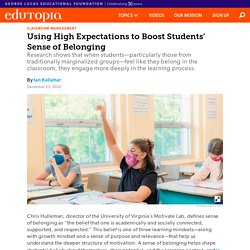
This belief is one of three learning mindsets—along with growth mindset and a sense of purpose and relevance—that help us understand the deeper structure of motivation. A sense of belonging helps shape students’ beliefs about themselves, their potential, and the learning context, and is likely to be especially beneficial for students from traditionally marginalized groups. By deliberately addressing belonging in our classes, we can help build deeper engagement, deeper learning, more fairness, and a more positive whole child school experience. Picture each of your students. As they enter school, either in person or online, do they feel safe and valued, and that their unique story matters in school? In class, how do you speak to them? But DEI work alone is not enough. Mental Health Primers.
Equity, Neuroscience and Cognitive Capacity. Editor’s Note: This is part four of a five-part series.
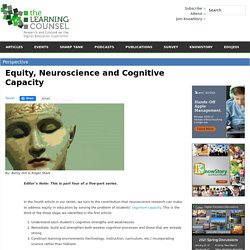
In the fourth article in our series, we turn to the contribution that neuroscience research can make to address equity in education by solving the problem of students’ cognitive capacity. This is the third of the three steps we identified in the first article: The Problem with "Learning Styles" When it comes to home projects, I am a step-by-step kind of girl.

I read the instructions from start to finish, and then reread and execute each step. My husband, on the other hand, prefers to study the diagrams and then jump right in. Think owner’s manual versus IKEA instructions. This preference for one approach over another when learning new information is not uncommon. Indeed the notion that people learn in different ways is such a pervasive belief in American culture that there is a thriving industry dedicated to identifying learning styles and training teachers to meet the needs of different learners. Just because a notion is popular, however, doesn’t make it true.
Learning Styles Debunked: There is No Evidence Supporting Auditory and Visual Learning, Psychologists Say – Association for Psychological Science – APS. Are you a verbal learner or a visual learner?

Chances are, you’ve pegged yourself or your children as either one or the other and rely on study techniques that suit your individual learning needs. And you’re not alone— for more than 30 years, the notion that teaching methods should match a student’s particular learning style has exerted a powerful influence on education. The long-standing popularity of the learning styles movement has in turn created a thriving commercial market amongst researchers, educators, and the general public.
The wide appeal of the idea that some students will learn better when material is presented visually and that others will learn better when the material is presented verbally, or even in some other way, is evident in the vast number of learning-style tests and teaching guides available for purchase and used in schools. Trauma-Aware Teaching Checklist. Welcome to BrainU. The Brain Architects Podcast: Brain Architecture: Laying the Foundation.
The Brain Architecture Game. The Brain Architects Podcast: Brain Architecture: Laying the Foundation. Homepage - Digital Promise Research Map. Design Ed: Connecting Learning Science Research to Practice: Angela Elkordy, Ayn Keneman: 9781564847492: Amazon.com: Books. Design Ed (Book) – Learning by Design (Companion Site) - International Society for Technology in Education. Curricular Materials. Course of Mind. Bringing the Science of Learning Into Classrooms. New research sheds light on the effects that childhood experiences—both good and bad—have on the developing brain. But are schools keeping up? “The 20th-century education system was never designed with the knowledge of the developing brain,” says Pamela Cantor, MD, who is part of a cross-disciplinary team of experts studying the science of learning and development.
“So when we think about the fact that learning is a brain function and we have an education system that didn’t have access to this critical knowledge, the question becomes: Do we have the will to create an education system that’s informed by it?” Contrary to the long-held belief that brain maturation is largely complete by the age of 6, we now know that our brains are malleable and continue to change dramatically well into our 20s.
This has profound implications for learning throughout the school-age years. There has been an error with the video. What Schools Can Do. Mariale Hardiman's Brain-Targeted Teaching Model. Resources on Learning and the Brain. Student Learning That Works: How brain science informs a student learning model (2018) - McREL International. Teachers as Brain-Changers: Neuroscience and Learning. By Wendi Pillars I'm an armchair neuroscientist, or at least I love learning about the brain, how it functions, and what recent findings mean for my practice as a teacher.

Bridging research findings to the realities of the classroom, however, is far easier said than done. In addition to navigating the daily challenges of our work, we must distinguish trendy "research-based" claims about the brain from those grounded in legitimate neuroscientific findings. And then we have to figure out how to apply what we've learned. Sifting through these claims to understand their origins is precisely the goal of my current research. Remember when conventional science wisdom claimed that the average person could learn and retain about seven chunks of information at a time?
This can be good: It forces us as teachers to narrow and hone our objectives, and to determine what is most important as we make decisions throughout the day. . #1. Here's how it happens at a basic level: #2. Self-evident, right? Nine Things Educators Need to Know About the Brain. The human brain wasn’t designed for industrial education.
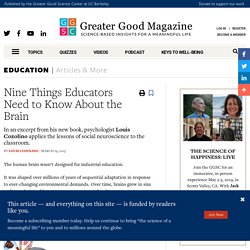
It was shaped over millions of years of sequential adaptation in response to ever-changing environmental demands. Over time, brains grew in size and complexity; old structures were conserved and new structures emerged. As we evolved into social beings, our brains became incredibly sensitive to our social worlds. The Learning Scientists. Science of learning: Why do we care? Cognition, Thinking & Understanding. How Learning Happens. How can schools better align their practices with what the science says about human learning?

Our new video series, featuring Linda Darling-Hammond, president and CEO of Learning Policy Institute, and Pamela Cantor, MD, founder and senior science advisor of Turnaround for Children, pairs research insights with a variety of illustrative strategies from schools, all grounded in the science of human learning and development. We think these techniques will resonate with educators everywhere: They are focused on taking advantage of the incredible opportunity to help children reach their full potential by creating positive relationships, experiences, and environments in which every student can thrive. In fact, the science is beginning to hint at even more dramatic outcomes.
Thinking and Learning. Domain 1 of the principles from psychology to enhance pre-K to 12 teaching and learning.
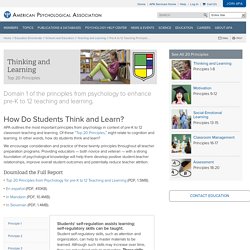
How Do Students Think and Learn? APA outlines the most important principles from psychology in context of pre-K to 12 classroom teaching and learning. Of these “Top 20 Principles,” eight relate to cognition and learning. In other words, how do students think and learn? We encourage consideration and practice of these twenty principles throughout all teacher preparation programs. Download the Full Report. Recommended Books on the Science of Learning – Retrieval Practice. Design your (educational) design work series: Books to get your learning sciences geek on… Remembering back to high school, college, or a workplace learning series, did you notice that in some classes you didn’t learn a thing, but in others, like magic, the whole world unfolded before you?
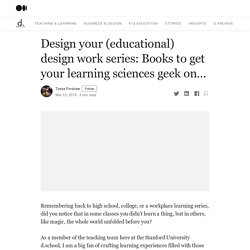
As a member of the teaching team here at the Stanford University d.school, I am a big fan of crafting learning experiences filled with those magic moments. And while there is absolutely a little magic in making them happen, there is also a whole lot of science… While Rich Cox Braden, Colin Coltrera and I have been designing our class Design Thinking Studio, for the upcoming 2019 Spring Quarter we have been drawing on the learning sciences to help us design some of those magic moments.
Here are a few examples of how it has inspired our decisions: The Science of Learning and Development Initiative. Learning Science - Chan Zuckerberg Initiative. Learning Sciences. Learner Variability Navigator. Turnaround for Children. Learning sciences. The Learning Sciences: Two Perspectives « Competency Works. Amelia Peterson In recent years, there has been a lot more talk in Education about the science of learning.
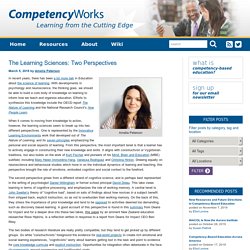
With developments in psychology and neuroscience, the thinking goes, we should be able to build a core body of knowledge on learning to inform how we teach and organise education. Efforts to synthesize this knowledge include the OECD report The Nature of Learning and the National Research Council’s How People Learn.
When it comes to moving from knowledge to action, however, the learning sciences seem to break up into two different perspectives. David Sousa: What are Teachers? How Learning Works - Changing Perspectives from Teaching to Learning on Vimeo. Peter Doolittle: How your "working memory" makes sense of the world. The Science of Learning and Development. Neuromyths by Tracey Tokuhama-Espinosa, Ph.D. Mayo 2017. Downloadable Materials. About the six strategies for effective learning resources: These resources were created based on research from cognitive psychology from the past few decades.
To learn more about how we created the materials, see this blog. The materials are intended to teach about principles of learning and to provide teachers and students with flexible guiding principles to guide learning and studying. However, they are not intended to fix all problems within education. Further, we cannot guarantee success, and we cannot predict students' grades based on the use of these strategies. How much do you know? (Anonymous) Neuroteach Network — The Center for Transformative Teaching & Learning. Course Of Mind. Resources on Learning and the Brain.
Turnaround for Children. Turnaround produces research-based tools that build environments, skills and mindsets to accelerate healthy student development and academic achievement. Educators across the country are looking for ways to better support their students’ cognitive, social and emotional development. Over the past 16 years, Turnaround has partnered with more than 100 schools. We have learned a lot from our work in classrooms and from scientific research on stress and brain development.
Now we want to share what we’ve learned. Resources. "You have brains in your head. You have feet in your shoes. You can steer yourself Any direction you choose. " --- Dr. Seuss. Readings, Research, and Resources — The Center for Transformative Teaching & Learning. The following is a list of books, articles, on-line trainings, and websites that have been integral to the research-informed work of the Center for Transformative Teaching and Learning and the writing of Neuroteach. Free, open, and high quality resources on the learning sciences.
By Judi Fusco and Pati Ruiz Below are some readings that can be used to introduce the learning sciences to a wide audience. Strategies to Prevent the Neurotoxic Impact of School Stress. Neurotoxic Boredom The chronic stress of sustained or frequent boredom correlates with neurophysiologic changes that impact cognition, memory, social and emotional behavior -- changes that affect school success.
Over time, high stress increases the risk for other medical conditions including heart disease, obesity and diabetes. Retrieval Practice: A Powerful Strategy to Improve Learning. Top 20 Principles for Early Childhood Teaching and Learning. How People Learn: Brain, Mind, Experience, and School: Expanded Edition. How People Learn II: Learners, Contexts, and Cultures.
Learning Differences – Friday Institute for Educational Innovation. Leveraging the Learning Sciences. Open Access Readings on the Learning Sciences – CIRCL. Understanding the Brain: The Birth of a Learning Science. Motivation: Leveraging the Learning Sciences. Frontiers of Innovation. TeachingWorks. Teaching and Learning Research Summaries: A collection for easy access. Aligning Education Policy with the Science of Learning and Development - Aurora Institute. Master of Education in Learning Sciences Education (M.Ed./Ed.S.) Earn Your M.Ed. or Ed.S. in Learning Sciences Education.